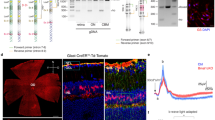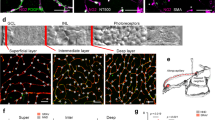Abstract
Neural activity generates increases in extracellular K+ concentration, [K+]0, which must be regulated in order to maintain normal brain function1. Glial cells are thought to play an important part in this regulation through the process of K+ spatial buffering2–4: K+-mediated current flow through glial cells redistributes extracellular K+ following localized [K+]0 increases. As is the case in other glia, the retinal Müller cell is permeable almost exclusively to K+ (ref. 5). Recent experiments6–8 have suggested that this K+ conductance may not be distributed uniformly over the cell surface. In the present study, two novel techniques have been used to assess the Müller cell K+ conductance distribution. The results demonstrate that 94% of all membrane conductance lies in the endfoot process of the cell. This strikingly asymmetric distribution has important consequences for theories concerning K+ buffering and should help to explain the generation of the electroretinogram.
This is a preview of subscription content, access via your institution
Access options
Subscribe to this journal
Receive 51 print issues and online access
$199.00 per year
only $3.90 per issue
Buy this article
- Purchase on Springer Link
- Instant access to full article PDF
Prices may be subject to local taxes which are calculated during checkout
Similar content being viewed by others
References
Gardner-Medwin, A. R. J. exp. Biol. 95, 111–127 (1981).
Orkand, R. K., Nicholls, J. G. & Kuffler, S. W. J. Neurophysiol. 29, 788–806 (1966).
Trachtenberg, M. C. & Pollen, D. A. Science 167, 1248–1252 (1969).
Gardner-Medwin, A. R. J. Physiol., Lond. 335, 393–426 (1983).
Newman, E. A. Soc. Neurosci. abstr. 7, 275 (1981).
Newman, E. A. Vision Res. 19, 227–234 (1979).
Fujimoto, M. & Tomita, T. Brain Res. 204, 51–64 (1981).
Newman, E. A. Soc. Neurosci. abstr. 9, 807 (1983).
Faber, D. S. thesis, Univ. New York, Buffalo (1969).
Miller, R. F. & Dowling, J. E. J. Neurophysiol. 33, 323–341 (1970).
Karwoski, C. J. & Proenza, L. M. J. Neurophysiol. 40, 244–259 (1977).
Newman, E. A. J. Neurophysiol. 43, 1355–1366 (1980).
Newman, E. A. & Odette, L. L. J. Neurophysiol. 51, 164–182 (1984).
Cohen, M. W. J. Physiol., Lond. 210, 565–580 (1970).
Castellucci, V. F. & Goldring, S. Electroenceph. clin. Neurophysiol. 28, 109–118 (1970).
Bader, C. R. Macleish & Schwartz, E. A. J. Physiol., Lond. 296, 1–26 (1979).
Author information
Authors and Affiliations
Rights and permissions
About this article
Cite this article
Newman, E. Regional specialization of retinal glial cell membrane. Nature 309, 155–157 (1984). https://doi.org/10.1038/309155a0
Received:
Accepted:
Issue Date:
DOI: https://doi.org/10.1038/309155a0
This article is cited by
-
Functional specialization of retinal Müller cell endfeet depends on an interplay between two syntrophin isoforms
Molecular Brain (2020)
-
Evaluating inner retinal dimples after inner limiting membrane removal using multimodal imaging of optical coherence tomography
BMC Ophthalmology (2018)
-
Fluid and ion transfer across the blood–brain and blood–cerebrospinal fluid barriers; a comparative account of mechanisms and roles
Fluids and Barriers of the CNS (2016)
-
Functional Hyperemia and Mechanisms of Neurovascular Coupling in the Retinal Vasculature
Journal of Cerebral Blood Flow & Metabolism (2013)
-
Glial K+ Clearance and Cell Swelling: Key Roles for Cotransporters and Pumps
Neurochemical Research (2012)
Comments
By submitting a comment you agree to abide by our Terms and Community Guidelines. If you find something abusive or that does not comply with our terms or guidelines please flag it as inappropriate.



